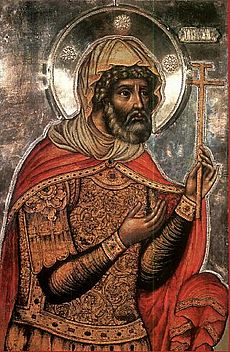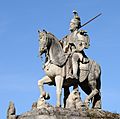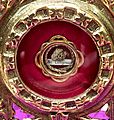Longinus facts for kids
Quick facts for kids SaintLonginus |
|
|---|---|

Statue of Saint Longinus by Bernini in Saint Peter's Basilica
|
|
| Born | 1st century in Sandiale or Sandrales of Cappadocia |
| Died | 1st century |
| Venerated in | Anglican Communion Coptic Orthodox Church Eastern Orthodox Church Oriental Orthodoxy Catholic Church |
| Major shrine | Inside St. Peter's Basilica, Vatican City |
| Feast |
|
| Attributes | Military attire, lance |
Longinus is the name given to a Roman soldier. He is known for piercing the side of Jesus with a spear during the Crucifixion. This story is found in the Gospel of John. In many Christian traditions, Longinus is believed to have become a Christian himself.
His name, Longinus, first appeared in an ancient text called the Gospel of Nicodemus. This text is considered "apocryphal," meaning it is not part of the official Bible. The spear he used is known as the "Holy Lance" in Christianity. This act is said to have created the last of the Five Holy Wounds of Christ.
This soldier is not named in the official Gospels. However, some stories say he was the centurion (a Roman army officer) who was at the Crucifixion. This centurion famously said that Jesus was the Son of God. Because of this, Longinus is often seen as one of the very first Roman converts to Christianity. Over time, his story grew, and he is now honored as a saint in the Roman Catholic Church, the Eastern Orthodox Church, and other Christian groups.
Contents
The Story of Longinus
The official Gospels do not give a name for the soldier who pierced Jesus' side. The name Longinus comes from the Gospel of Nicodemus, an apocryphal text. Longinus was not always considered a saint in early Christian stories.
The name Longinus likely comes from the Greek word lonche (λόγχη). This word means "lance" or "spear." It is the same word used in the Gospel of John to describe the spear. The name first appeared next to a soldier holding a spear in an old manuscript from the year 586. This manuscript was called the Rabula Gospels.
The spear itself became known as the Holy Lance. Later, it was sometimes called the "Spear of Destiny." This spear was highly respected in Jerusalem by the 500s. The Holy Lance also appears in the legends of the Holy Grail.
Some later stories, from after the 10th century, added that Longinus had problems with his eyesight. Some accounts say he was blind or had poor vision. The Golden Legend, a famous collection of saints' lives, says he saw special signs from heaven before he became a Christian. It also suggests his eye problems might have been due to illness or old age.
It is said that Longinus's body was lost and found twice. The second time it was found was in Mantua, Italy, in 1304. Along with his body, a Holy Sponge stained with Christ's blood was also found. Some stories claim Longinus helped clean Christ's body after it was taken down from the cross. Parts of his relics (holy objects) were later sent to other places, like Prague. Some sources also say his body was found in Sardinia, while Greek stories say he died as a martyr in Cappadocia.
Honoring Saint Longinus Today
Longinus is honored as a martyr (someone who died for their faith) in several Christian churches. These include the Roman Catholic Church, the Eastern Orthodox Church, and the Armenian Apostolic Church.
His feast day is celebrated on October 16 in the Roman Martyrology. This is a list of saints honored by the Roman Catholic Church. It mentions him as the soldier who opened the side of the crucified Lord with a spear. Before 1969, his feast day in the Roman Catholic Church was March 15. The Eastern Orthodox Church also celebrates him on October 16. In the Armenian Apostolic Church, his feast is on October 22.
A famous statue of Saint Longinus was made by Gian Lorenzo Bernini. It is one of four statues located under the dome of Saint Peter's Basilica in Vatican City. A small piece of what is believed to be the Holy Lance is also kept in the Basilica.
Longinus and his story are also part of the Moriones Festival. This festival takes place during Holy Week on the island of Marinduque, in the Philippines.
Longinus in Brazil
Finding Lost Things
In Brazil, Saint Longinus is known by the folk name "São Longuinho." People believe he can help find missing objects. When someone loses something, they might say a chant:
São Longuinho, São Longuinho, se eu achar [missing object], dou três pulinhos!
(São Longuinho, São Longuinho, if I find [missing object], I'll hop three times!)
This tradition comes from a story about the saint when he was in Rome. It is said he was short and could easily see under tables at crowded parties. Because of this, he would often find and return items that others had dropped. The three hops are either a sign of respect for the saint or a prayer to the Holy Trinity.
Gallery
See also
 In Spanish: Longinos (centurión) para niños
In Spanish: Longinos (centurión) para niños
- List of names for the Biblical nameless
- Moriones Festival
- Wandering Jew, a figure with whom he is sometimes identified








